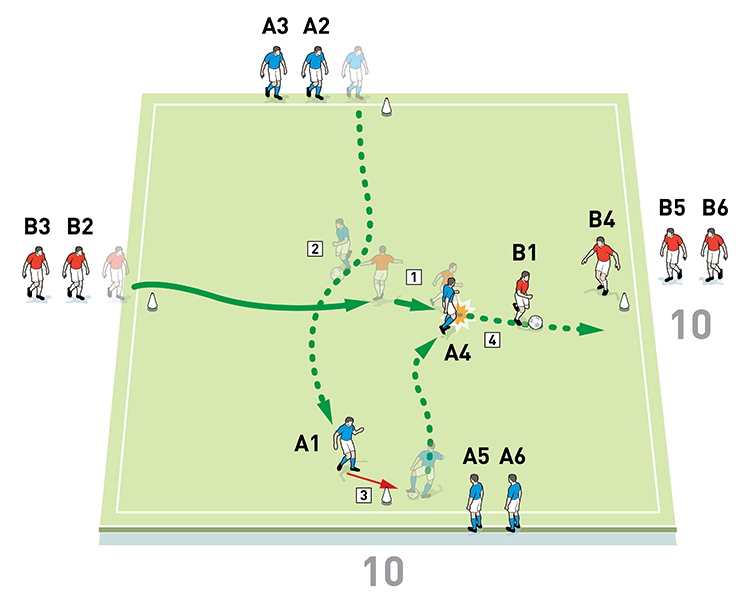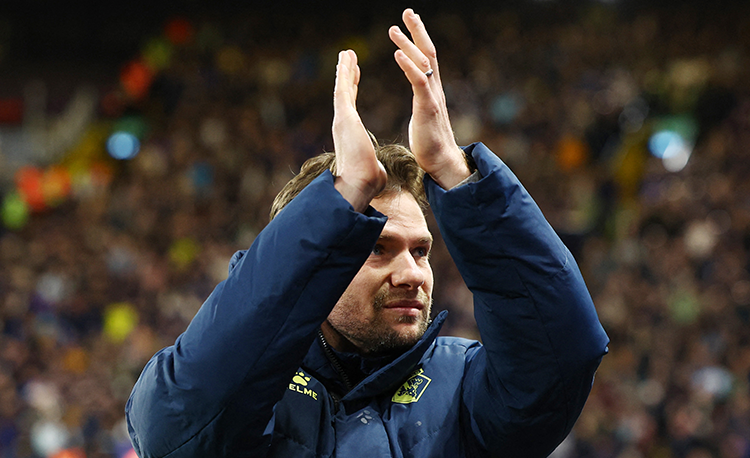Counter-pressing
This session is aimed at influencing player behaviour on the loss of possession. We work very hard to affect player behaviour in the transition from attack to defence, as the counter-press is an important feature of our playing style.

| Area | Up to 24x18 yards |
| Equipment | Balls, bibs and cones |
| No. of Players | Up to 15 players |
| Session Time |
Total: 70mins, Practice 1: 15mins, Practice 2: 25mins, 6v6 +3 rondo: 30mins |
This session is aimed at influencing player behaviour on the loss of possession. We work very hard to affect player behaviour in the transition from attack to defence, as the counter-press is an important feature of our playing style.
We aim to be a high energy, hyper mobile team. We see giving the ball away as an opportunity to win it back and know that we can be at our most dangerous after winning the ball back high up the pitch. The belief gives our players freedom and confidence in possession, as they aren’t scared of losing the ball.
At some point in every training week we will do some counter-pressing work. The nature of counter-pressing work means you can achieve excellent physical returns from your players through the high intensity running and accumulative sprints.
If we are playing against possession-based or counter-attacking teams, we will often use counter-pressing drills as the focus of our work in the lead up to games.
What do I get the players to do?
Practice 1
We set up for this training practice in an area of 10x10 yards, with four cones marking out a passing diamond.
For this activity we are using eight players positioned on the cones, as shown [1a].
1a

2. Player 1 gets a pass away to player 3 on his right and moves to the cone on his left. Player 2 takes player 1’s position
3. Player 4 runs to press player 3 the moment player 1 passes. Player 3 then passes right to player 5 and moves to the cone on his left. Player 4 takes player 3’s place
4. Player 5 passes right to player 7 and moves left
5. Player 7 passes back to the start, where 2 and 3 wait, and then moves left. This pattern continues until 90 seconds is up
The players follow the passing, pressing and movement pattern shown in the diagram for 90 seconds until the coach calls for a switch in the direction of play. Players then follow the same passing, pressing and movement pattern in the new direction.
1b

2. Player 8 receives and is pressed by player 4 but gets a pass off left to player 7 before running to the cone on his right
3. The pattern continues for 90 seconds until the coach calls for a switch of direction
We work in three-minute blocks and rest before repeating.
What do I get the players to do next?
Practice 2
We set up in the same 10x10-yard area as before. Here we’re using 12 players, split into two teams of six. Half the members of each team start on the cone opposite the other half of their team, as shown [2].
2

2. Team A start as attackers. The first player dribbles across and beats the defender in a 1v1
3. If the attacker makes it across, he passes to a team mate, who now tries to dribble across and get past the defender
4. If the defender wins the ball, team B become attackers. He dribbles towards his team mates. The old attackers must now take on the role of defenders
Here Team B start as the defending team and one player goes into the centre of the area. Team A are attacking and the first player dribbles across the square and attempts to beat the defender in a 1v1. If the attacker makes it across the area, he passes to a team mate on that side, who now dribbles across in the other direction and tries to beat the defender. If the defender wins the ball, as shown, possession changes hands and the attackers immediately become the defenders. Encourage players to react quickly to the changes in possession.
Every time a dribbler successfully makes it across to the other side, his team earns a point. At the end, the team with the most points is the winner.
How do I progress the session?
6v6 +3 rondo
We set up an area of 24x18 yards. We’re using 15 players, split into a possession team of six, a defending team of six, and three neutrals, or “magic” players. The three magic players set up with one at either end and one in the centre. The possession team has four players on the outside and two in the middle – they must try to keep possession using the assistance of the three magic players. The six defending players are in the centre of the area and they must try to press and win the ball back, as shown [3a].
3a

2. The red possession team has four players on the outside and two in the middle. They must keep possession using the neutrals
3. The blue defending team of six is in the centre and must press to win the ball back
If the defenders win the ball, they must secure their possession by passing to one of the magic players at one end of the area and then continue to play from there.
The team that has lost possession must now set up as the new defending team, with the four outside players switching places with four of the defenders in the centre. As they have become the new defending team, they must immediately start to counter-press and must try to win the ball back from the new possession team, as shown [3b].
3b

2. The team losing possession becomes the defending team, with their four outside players switching with the four defenders in the centre. Now they counter-press
3. The original defenders are now the possession team
The possession team can score points if it is able to string six passes together, or if the players manage to move the ball from one end magic player to the other.
Touch restrictions can be introduced so that after six passes the possession team is restricted to two-touch. If they are able to put two sets of six passes together, the touch restriction can go to one-touch. This will create more turnovers of possession.
What are the key things to look out for?
Look out for reactions to the loss of possession – you want to see quick counter-pressing on transition.
They should be forcing opponents on to their weaker foot. The angle of approach is important when pressing, and players should try to keep play on one side, making the pitch small and using the sideline as a defender.
We also want to see our players securing possession once they have won the ball back.
Editor's Picks
Attacking transitions
Deep runs in the final third
Using the goalkeeper in build-up play
Intensive boxes drill with goals
Penetrating the final third
Creating and finishing
My philosophy
Pressing initiation
Compact team movement
Coaches' Testimonials

Alan Pardew

Arsène Wenger

Brendan Rodgers

Carlos Carvalhal

José Mourinho

Jürgen Klopp

Pep Guardiola

Roy Hodgson

Sir Alex Ferguson

Steven Gerrard
Coaches' Testimonials

Gerald Kearney, Downtown Las Vegas Soccer Club

Paul Butler, Florida, USA

Rick Shields, Springboro, USA

Tony Green, Pierrefonds Titans, Quebec, Canada
Join the world's leading coaches and managers and discover for yourself one of the best kept secrets in coaching. No other training tool on the planet is written or read by the calibre of names you’ll find in Elite Soccer.
In a recent survey 92% of subscribers said Elite Soccer makes them more confident, 89% said it makes them a more effective coach and 91% said it makes them more inspired.
Get Monthly Inspiration
All the latest techniques and approaches
Since 2010 Elite Soccer has given subscribers exclusive insight into the training ground practices of the world’s best coaches. Published in partnership with the League Managers Association we have unparalleled access to the leading lights in the English leagues, as well as a host of international managers.
Elite Soccer exclusively features sessions written by the coaches themselves. There are no observed sessions and no sessions “in the style of”, just first-hand advice delivered direct to you from the coach.









